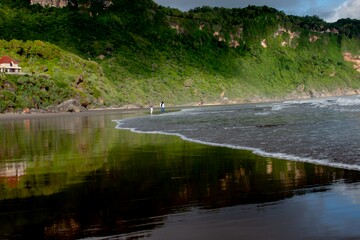What is an ecosystem?

An ecosystem is a community of living organisms and their non-living environment.

An ecosystem is a community of living organisms and their non-living environment.
Ecosystem is a group of living things that live together in a place. It includes all the plants, animals, and other living things in that place, as well as the non-living things like water, soil, and air.
Ecosystems can be big or small. A forest is a big ecosystem, and a backyard is a small ecosystem. Even a puddle of water is an ecosystem!
The living things in an ecosystem all depend on each other. Plants make food for animals to eat, and animals help to spread plant seeds. Decomposers break down dead plants and animals, and their nutrients go back into the soil to help new plants grow.
Ecosystems are very important. They provide us with food, water, and air to breathe. They also help to regulate the climate and protect us from natural disasters.
Here are some examples of ecosystems:
- Forests
- Grasslands
- Deserts
- Oceans
- Lakes
- Rivers
- Backyards
- Puddles
Ecosystems work like a big machine. All the living and non-living things in an ecosystem are connected. They all depend on each other to survive.
For example, in a forest, trees make food for animals to eat. Animals help to spread plant seeds. Decomposers break down dead plants and animals, and their nutrients go back into the soil to help new plants grow.
If one part of an ecosystem breaks down, it can affect all the other parts. For example, if too many trees are cut down, there will be less food for animals to eat. This could lead to a decline in the animal population, which could then affect the decomposer population.
Ecosystems are important for many reasons. They provide us with food, water, and air to breathe. They also help to regulate the climate and protect us from natural disasters.
Ecosystems are also home to many different plants and animals. These plants and animals are important for our planet's biodiversity. Biodiversity is the variety of life on Earth. It is important for our planet's health and for our own survival.
How can we protect ecosystems?
- Reduce our consumption of resources
- Recycle and compost
- Support sustainable agriculture
- Volunteer our time to help protect ecosystems
By protecting ecosystems, we are protecting our planet and our future.
Ecosystems are amazing things. They are complex and interconnected, and they provide us with many benefits. We need to do everything we can to protect them.
How can we learn more about ecosystems?
We can learn more about ecosystems by observing and exploring them. Scientists who study ecosystems go out into nature and watch how plants, animals, and other living things interact with each other and their environment. They also conduct experiments and collect data to better understand how ecosystems work. As kids, we can learn about ecosystems by going on nature walks, visiting nature centers, and reading books or watching videos about different ecosystems. For example, we can observe how birds build nests in trees or how ants work together to find food in our own backyard.
How do ecosystems change over time?
Ecosystems are always changing! They can change slowly or quickly, depending on things like climate, natural events, and human activities. For example, a forest ecosystem might change slowly over many years as old trees grow tall and new trees take their place. On the other hand, a wildfire can quickly change a forest ecosystem by burning down trees and plants. When ecosystems change, it can impact the plants and animals that live there. Some animals may need to find new homes or sources of food if their habitat changes.
What are some threats to ecosystems?
There are several threats to ecosystems, and they can come from both nature and humans. Natural threats include things like wildfires, floods, and droughts, which can disrupt the balance of an ecosystem. Humans can also harm ecosystems by cutting down too many trees, polluting water, or destroying habitats for buildings and roads. Pollution from factories and cars can also harm ecosystems by affecting the air, water, and soil. One example of a threat to an ecosystem is when people throw plastic bottles into a river, which can harm the fish and plants living in the water.
What are the different parts of an ecosystem?
An ecosystem is made up of different parts that all work together. One important part is the living things, like plants, animals, and microorganisms. They rely on each other for things like food and shelter. Another part of an ecosystem is the non-living things, such as air, water, soil, and sunlight. These non-living things provide the necessary resources for the living things to survive. For example, plants use sunlight to make their own food through a process called photosynthesis. The soil provides nutrients for the plants, and animals might find their homes in trees or in underground burrows. Every part of an ecosystem plays a role in keeping the ecosystem healthy and functioning.

An ecosystem is a community of living organisms and their non-living environment.